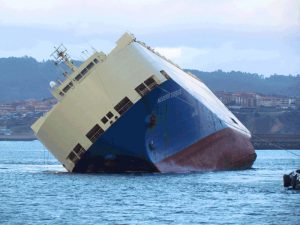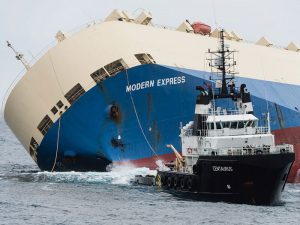
Salvage: Under Pressure
On January 29, 2016, the Roll-On/Roll-Off (RO/RO) carrier Modern Express, a Panama-registered ship transporting 3,600 tonnes of wood and construction machinery from Gabon to France, was caught in as severe storm in the Bay of Biscay. Battered by huge waves, the vessel developed a severe list and lost engine power. The captain sent out a distress signal, and the vessel’s 22 crew members were airlifted to safety by two Spanish helicopters, leaving Modern Express to founder in heavy seas without crew or power.
Rapid response team SMIT Salvage, a Dutch salvage and towing company that specializes in emergency operations, was called to handle the case, and the DNV GL ERS team was activated.Within hours, SMIT had chartered two heavy tugboats to secure the vessel and had a ten-man salvage crew on the scene. DNV GL put three technical experts on the case to provide advice on stability and structural strength issues based on the original vessel drawings and a predefined 3D computer model.
Aware that the wind and sea conditions were pushing Modern Express towards the southwestern coast of France, the SMIT team attempted to attach a tow line to the stricken vessel. Rough seas made this impossible, but on February 1, four SMIT salvage experts were lowered onto the deck of Modern Express by a helicopter, where they were able to attach towlines. This allowed a tug to turn the vessel and steer it away from immediate danger. While no personnel were injured during the operation and the loss of the vessel was no longer an immediate threat, the job was far from over, and the focus of the operation shifted to guiding the vessel to a safe port.
Safe harbor
“Our first priority in a crisis situation is to carry out the necessary calculations to assess the condition of the vessel and to advise personnel on-site how best to manage the crisis,” says Øyvind Træthaug, Principal Engineer Emergency Response Service at DNV GL.“Together, our duty teams in Oslo and Hamburg handle about 40 cases a year. Not all require salvage operations, but when they do, we try to support the efforts of the salvors. We have worked extensively with SMIT in the past, and have developed a good, cooperative relationship with them.”
According to Richard Janssen, Commercial Direct or of SMIT Salvage, the greatest challenge in any salvage operation is gaining timely access to reliable information. “Until we get people on board to assess the condition of the vessel itself, it is difficult to get an accurate picture of what we are dealing with,” he says. “The stability calculations we receive from the class of the vessel, combined with analysis from our own team, can make a big difference in how we approach salvage operations.”

Challenging conditions
Janssen says that the greatest challenge in any emergency salvage operation is coordinating the flow of information between various stakeholders. “In a case like this, we work with the owner, local maritime authorities, lawyers and underwriters to coordinate our response. We received excellent support from DNV GL in this situation,” says Janssen, adding that the hands-on assessment of the vessel’s condition was difficult. “The vessel was listing at 40 degrees, with some decks partially submerged, making it difficult for our experts to assess structural damage.However, DNV GL’s calculations helped confirm our own analysis of the vessel’s condition and we agreed the ship was seaworthy enough to be towed.”
Righting the ship
After having applied for a place of refuge in accordance with the new EU Operational Guidelines, the Spanish authorities gave their approval by February 2 for Modern Express to head for the harbor entrance in the Port of Bilbao in Spain, where a boarding team of eight SMIT salvors were put onto the vessel to connect up additional tugs for berthing.The vessel was secured to the dock with specialized shore-tension equipment after the necessary inspections could be carried out.The next challenge was how to right the ship.
“We discussed using counterweights to bring the ship upright, but as the SMIT team was able to assess the vessel more thoroughly, we verified and helped SMIT to improve a nine-step dewatering sequence using pumps and ballast tanks to gradually right the ship,” says Træthaug, who was very happy with the result.Work began on February 6 and the team managed to reduce the vessel’s list from 51 degrees to zero.
“We measure the quality of our service in how quickly we can produce and deliver useful information and recommendations for decision support in critical situations,” adds Rossen Panev, a DNV GL Principal Engineer who collaborated on the case with Træthaug. “Working closely with salvors like SMIT gives us the opportunity to enhance each other’s skill sets and provide the customer with the best possible advice when the pressure is on and they need to make fast decisions.”

